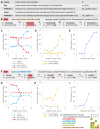Evidence that transient replication errors initiate nuclear genome mutations
- PMID: 40694689
- PMCID: PMC12282765
- DOI: 10.1093/nar/gkaf679
Evidence that transient replication errors initiate nuclear genome mutations
Abstract
DNA synthesis during genomic replication generates mismatches that lead to mutations. Point mutations may be caused by base-base mismatches that yields base substitutions or by primer- or template-strand slippage, which yield insertions and deletions (indels), respectively. Evidence obtained 40 years ago with DNA polymerases in vitro indicated that transient DNA intermediates also initiate substitutions and indels. Here, we provide evidence in vivo that the rates of specific single-base mutations at or adjacent to the 3'-terminus of the primer strand of mononucleotide runs increase change with run length. We propose that four such TIM (transient initiator mutagenesis) pathways are active during replication of the yeast nuclear genome in vivo and may be a universal feature of DNA replication.
Plain language summary
Evidence is provided that the rates of specific single-base mutations at or adjacent to the 3'-terminus of the primer strand of runs of the same base pair change with run length. We propose that four such pathways are active during replication of the yeast nuclear genome in vivo, that they may be a universal feature of DNA replication in many different organisms, and that the mutations they cause may be associated with human diseases.
Published by Oxford University Press on behalf of Nucleic Acids Research 2025.
Conflict of interest statement
None declared.
Figures





Similar articles
-
Can a Liquid Biopsy Detect Circulating Tumor DNA With Low-passage Whole-genome Sequencing in Patients With a Sarcoma? A Pilot Evaluation.Clin Orthop Relat Res. 2025 Jan 1;483(1):39-48. doi: 10.1097/CORR.0000000000003161. Epub 2024 Jun 21. Clin Orthop Relat Res. 2025. PMID: 38905450
-
Idiopathic (Genetic) Generalized Epilepsy.2024 Feb 12. In: StatPearls [Internet]. Treasure Island (FL): StatPearls Publishing; 2025 Jan–. 2024 Feb 12. In: StatPearls [Internet]. Treasure Island (FL): StatPearls Publishing; 2025 Jan–. PMID: 31536218 Free Books & Documents.
-
Double-strand break repair-associated intragenic deletions and tandem duplications suggest the architecture of the repair replication fork.bioRxiv [Preprint]. 2023 Oct 13:2023.10.09.561461. doi: 10.1101/2023.10.09.561461. bioRxiv. 2023. PMID: 37873277 Free PMC article. Preprint.
-
Systemic treatments for metastatic cutaneous melanoma.Cochrane Database Syst Rev. 2018 Feb 6;2(2):CD011123. doi: 10.1002/14651858.CD011123.pub2. Cochrane Database Syst Rev. 2018. PMID: 29405038 Free PMC article.
-
Topical antibiotics with steroids for chronic suppurative otitis media.Cochrane Database Syst Rev. 2025 Jun 9;6(6):CD013054. doi: 10.1002/14651858.CD013054.pub3. Cochrane Database Syst Rev. 2025. PMID: 40484406
References
MeSH terms
Grants and funding
LinkOut - more resources
Full Text Sources

